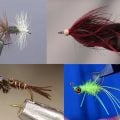What’s the Right Length for a Trout Rod?
Have a question you want answered? Email it to us at ask@midcurrent.com.
Question: I understand that you might want a really short rod for small streams and a 10-footer for float-tube fishing or steelheading, but when you’re buying a trout-weight rod (say 4 through 7), how do you decided whether you want an 8-1/2 footer or a 9-footer? Most companies offer the rods in both lengths. Does the slight difference in length really make a difference? If so, what?
John K., Bedford, NH
Answer: Well John, I’m going to take the high road and resist making any of the hundred jokes involving the phrase “six inches” that occurred to me almost immediately, focusing instead on what’s actually a really interesting question.
As is my wont in these situations, I’ve thrown the question to experts around the globe to see what they think about the relative merits of these very common rod lengths.
Tom Rosenbauer, author of the Orvis Guide to Fly Fishing and the soon-to-be-released Orvis Guide to Small-Stream Fly Fishing: I think it makes a difference if you plan on doing a lot of nymphing or fishing dries across tricky currents. I can cast as far as needed with an 8½-foot rod, but it’s the mending and line control where I sometimes feel hindered with the shorter rod. If in doubt, I’d say always go with the 9-footer. The weight difference these days is minimal, and if you are choosing between an 8½-foot and a 9-foot rod, chances are you are not worried about tight casting spots. Even for smaller Eastern rivers like the Battenkill or Willowemoc, I use a 9-footer.
Jim Bartschi, president of Scott Fly Rod Company: Yes, 6 inches do make a difference, most notably in the swing weight, or perceived weight, of the rod. The shorter rod will feel substantially lighter in the hand and through the casting stroke. Even 3 or 4 inches make a difference.
We tend to view rods between 8½ and 9 feet as “dry-fly style” rods that are very comfortable and easy to cast. They generate high line speed and are very accurate. They aren’t our first choice for fishing applications that require lots of roll casting and mending, or for casting some of the bigger trout rigs seen on rivers today—like double streamers or large indicators with multi-fly rigs underneath them—but for more “typical” applications, like fishing a hatch or hopper-dropper fishing, a trout rod under 9 feet but at least 8.5 feet is ideal.
Dave Kumlien, longtime guide and outfitter and head of Trout Unlimited’s Aquatic Nuisance Species program: Good question! Having sold fly rods for over 25 years, it is a question I was often asked. My response is that from a fishing and casting standpoint, I don’t think there is that much difference between the 8½ and 9 feet. To me, the key decision is the choice of line weight. Choosing the line weight appropriate for the size of flies one fishes, the average size of fish one is pursuing, and the conditions under which one fishes i.e. lots of wind, long casts with big flies on big water or smaller flies under more delicate conditions, is to me the most important choice. I suppose the physicist could calculate the advantages of 6 more inches, but I can’t say that I’ve ever really attached that much significance to the difference.
I’ve always told folks to cast the rods they were considering buying, and to purchase the one that felt the best to them and which best seemed to fit the fishing they most often liked to do. In other words, if a customer owned a drift boat and liked to float our big Montana rivers like the Madison and the Yellowstone throwing larger dries, nymphs, and streamers, I’d generally recommend the 9- to 9½-foot rods. If the angler did a lot of wading, liked fishing the smaller streams, I’d generally recommend the 8- to 8½-footers.
Larry Kenney, fiberglass-rod builder and co-founder of Scott Fly Rod Company: Rod length choices seem to be governed as much by fashion and a pack-mentality as by anything else. A 9-foot 5-weight rod is the current default choice for most trout fishing because that’s what everyone recommends, what’s frequently stocked, and what therefore sells the most—particularly to folks who aren’t real confident about what they need. That configuration wasn’t always the case. From the 1960s to early 1970s, the fly-fishing world was fixated on short rods, a reaction, I imagine, to the long and rather heavy rods of the pre-WWII era and to an emerging dry-fly culture. Line-weight choices were different forty years ago, too, with more anglers fishing the equivalent of 6- and 7-weights for trout. Did folks fishing 7½-foot 6-weights take fewer trout? I doubt it.
Graphite made long rods for light lines lighter and more practical, and the pendulum swung back again. We sold them as offering better line control and for the opportunity to fish a more delicate light line, but they also sold because they were new. The American angler loves “new”—it’s a promise of success and a great excuse for not practicing with what you already have while still hoping for better results. Long graphite rods also sold because more Eastern anglers were coming West to fish larger western rivers; there’s something about big water that makes you feel positively undergunned if you’ve got a little rod, despite the fact that the fish may be right in front of you.
In any event, the question isn’t whether you should buy an 8½-foot or a 9-foot trout rod, but rather what rod will best handle a reasonable sample of the situations your fishing presents and do so in a manner that you enjoy. I’d weight both those criteria equally, by the way. If you spend a lot of time high-sticking or fishing an indicator, a 9-foot rod might make sense simply because the length offers easy mending and line control, regardless of distance. But if you’re fishing dries at normal distances—which generally don’t exceed 40 feet—you might be happier with an 8-foot rod, which can be quicker to put in play when a fish takes. You might also choose to limit the size of fly and the distance you can effectively fish it, and use your 7-foot 4-weight rod everywhere you go. The fashion police will be annoyed, but why should you care?
Another solution, of course, is to own a bunch of rods, so you can pick and choose, and fret endlessly over what to use. Or both. Rod manufacturers will love you, and it’s all grist for the outdoor writer’s mill.
Brian Grossenbacher, Montana-based guide and photographer: If you plan to fish out of a drift boat, I highly recommend going with the longer rod. Surprisingly, the difference between an 8½- and a 9- foot rod is monumental when fishing out of a drift boat. Not only does the longer rod aid in mending line, but it also helps keep the flies above the anglers’ and guide’s head. Another benefit of the longer rod for the fisherman in the back of the boat is that it keeps the fly line clear of the oars much better than an 8½-foot rod.
Brant Oswald, Livingston-based guide and writer: First of all, let’s agree that the fate of the world is not resting on the decision between an 8½- and a 9-foot trout rod. (And you haven’t even mentioned the issue of 8-foot, 8-inch and 8-foot, 9-inch rods.) But there are differences, and anglers with even a modicum of casting experience will be able to notice some of them. The first is that casters often find shorter rods to be more accurate, especially at shorter casting ranges. (For a more detailed discussion of this issue, take a look my article on casting accuracy here onMidCurrent.)
The shorter rod is also a bit lighter—the actual weight difference between an 8½- and a 9-foot rod (comparing similar designs and hardware, as with different lengths of the same model of rod) is minimal, but casters often find the shorter rod “feels” noticeably lighter and quicker. Part of this is physics, but part of it is also a reflection of a rod designer’s desire to make a certain rod perform in a particular way. It is not at all unusual for different lengths of rod—in the same product line by the same manufacturer—to differ slightly in terms of both rod action and stiffness. My advice for the buyer: compare the different lengths side-by-side if possible, and cast each one to make sure it has the casting performance and feel that you’re after.
Of course, there is an argument for the 9-foot rod: 6 inches of extra rod length offers a slight advantage in mending and line control, especially at longer fishing distances (and the weight difference and accuracy issues, says the 9-foot rod fan, are not that big a deal.)
What do I do personally? I base my decision on the size of water I am fishing. I fish 8½- foot 3- and 4-weight rods on smaller spring creeks, but switch to a 9-foot 4weight for fishing bigger tailwaters like the Missouri or Bighorn, where longer casts (and longer mends) are more typical. I think an 8½- foot 5-weight is perfect for wade fishing on medium-sized freestone streams (the Gallatin and Boulder are my local examples), as the angler usually wades reasonably close to the target, but I almost always fish a 9-foot rod out of a drift boat.
Carl McNeil, New Zealand-based casting instructor and filmmaker: Keeping in mind that a fly rod is simply a flexible lever, a longer lever will do a more effective job of throwing a longer line, all things being equal. The extra length also offers some advantages when mending and roll casting. However, longer rods make things a little more difficult when it comes to netting fish, presenting casts in and around overhanging vegetation, and fishing smaller streams. So, in a nutshell, if distance, mending, and reach were important to me, I’d go for the longer rod. If I was fishing smaller streams with lots of over hanging trees and vegetation, the shorter rod would prove far more versatile.
Steve Hemkens, Division Manager, Orvis Rod & Tackle: To know is to love. 8½-foot rods tend to be really sweet… whether it’s a 4-weight or a 5. There is something about that extra 6 inches to trade up to a 9-footer that changes the character of a rod. In most series, regardless of manufacturer, it’s usually the 8½- foot 5-weight that’s the sweetest of the lot. Supremely balanced, smooth, great feel, plenty of power. The reason for this is pretty straightforward. To get a 9-foot rod that performs from tip to butt, you need a wider flag, and more material along the whole length of the rod than you would for the same rod that’s 6 inches shorter, so the resulting tool is heavier in the hand. This is easy to see when you cast a 8½-, a 9-, a 9½-, and a 10-foot rod all of the same family (assuming they all follow the same design criteria). Invariably each 6-inch increment adds weight and clumsiness—to extent that if it were just a question of casting performance, weight in hand, and pure joy to fish, the 8½-rod would win every time. The trade-off is that when you’re wading deep, nymphing bigger water, or fishing out of a drift boat, that extra “reach” and additional power that a 9-footer (or more) affords is worth the extra weight in hand. So if you wade-fish small to medium rivers and want one rod that can cast dries, nymphs and streamers, and that you’ll love more that any rod you’ve ever owned, a 8½-foot 5-weight is hard to beat.
Matthew Long, guide based in Livingston, Montana: I am astounded by the number of people who think that a shorter rod is more effective than a longer rod,regardless of the size of the water you are fishing. I grew up in central Pennsylvania, where a longer rod meant spooking fewer brook trout. After working as an outfitter/guide in the Paradise Valley area of Montana for the last 18 years, I still have the same opinion—9 feet is always better than 8½ feet. Tom Miner Creek, a small tributary of the Yellowstone, is as brushy as any little brook-trout stream on the East Coast that is covered with mountain laurel. If you learn how to sling-shot cast, or be a dapper or jigger effectively while staying away from the creek you are fishing, you can catch a lot more fish. Bar none though, the most important reason for having a longer rod in your hand is to be in control of your drift. Reach casting and mending are the two of the most important fly-fishing skills that longer rods can help to improve.












